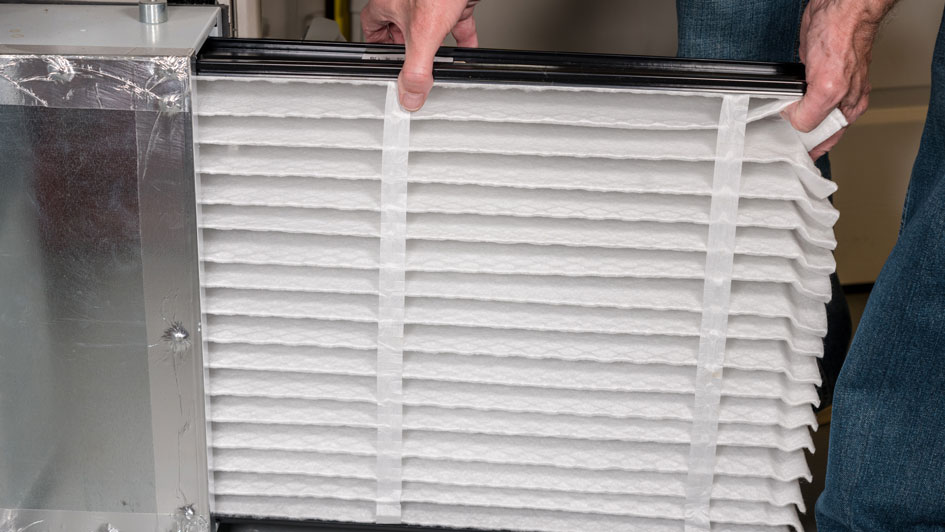
Choosing the ideal furnace filter and changing it when it becomes dirty is as important to your HVAC system as changing the oil is to your car. Each plays a critical role in keeping its system operating safely, efficiently and for a long time.
A clogged furnace filter loses its effectiveness, allowing potentially harmful particles to circulate through your home. It also restricts airflow, which can damage your furnace and shorten its life span.
Making sure your furnace uses a clean filter that is suitable for your needs is not only about keeping your furnace running efficiently. It’s also about delivering healthy indoor air quality for your home.
Your health is important to the HVAC professionals at Allstar Heating & Air Conditioning. We've long worked with an eye on bettering indoor air quality in Buellton. Here, we’ve answered frequent questions about HVAC filters, including that particularly tricky question of what direction do you point a filter in your furnace or air conditioner?
When to Replace the Air Filter in Your Furnace
It is critical to replace dirty air filters in a furnace or air conditioner periodically. Dirt-clogged filters cause the system to worker harder than it should because it takes more energy to move air through the plugged-up filter.
Officials suggest inspecting your furnace filter every 30 days and replacing it if it’s dirty. You’ll know if your filter needs changing because it will coated with dirt or dust. People who have pets that shed will probably have to replace their furnace air filter more often, because a good air filter will trap pet hair circulating in a home.
How to Find the Furnace's Air Filter
In general, a furnace air filter is usually found in the return air duct or blower compartment before the return air reaches the furnace. This makes sure air being pulled into the system is filtered before it moves through the furnace components and is heated.
Depending on the type of furnace, the filter may be positioned on the right, left, bottom or in some cases, on the inside of the furnace. It's generally housed inside of a slot, frame or cabinet for simple access and replacement. Always refer to your furnace's owner manual for facts concerning filter location of your furnace.
Is My Furnace Filter Just a Type of Air Filter?
The simple answer is, yes. In HVAC, a furnace filter and an air filter or AC filter are essentially identical. While people may call them different things based on the current season— summer or winter—they are all filters that clean the air in your home.
They each remove dust, allergens, bacteria and other particulates from the air that is drawn into the furnace and air conditioning system, making sure the air distributed throughout your home is clean and safe.
What Is the MERV Rating System and What Rating Is Best for Me?
Once you locate your old furnace filter and determine when it should be changed, it’s time to pick a replacement. That means deciding on the level of filtration that you need. One method to do this is by picking an appropriate MERV rating for your needs.
MERV stands for Minimum Efficiency Reporting Values. The MERV rating indicates the effectiveness of air filters at trapping airborne particles. The rating scale ranges from 1 to 20, with higher numbers indicating enhanced capabilities to filter tinier particles.
Experts say a filter with a MERV rating between 8 and 13 offers a good balance between having healthy indoor air quality without needlessly restricting airflow. However, people with some health conditions may need to purchase a filters with a higher MERV rating.
How to Place the Air Filter in a Furnace or Air Conditioning System
Installing an air filter in a furnace or air conditioner the proper way is crucial for the efficient operation of the system. Air filters are supposed to face a particular direction, indicated by an arrow printed on the side of the filter frame. The filter should be installed with this arrow pointing in the direction of the furnace or air conditioner, which is the direction of the airflow. If you're doubtful about the airflow direction, remember that air always moves from the return duct towards the heat or cooling source. Therefore, make certain the arrow points in the direction of the furnace or air conditioning unit.
Many people have difficulty remembering which direction to face an air filter. To help remember, consider snapping a quick photo with your mobile phone after the filter has been correctly installed by a professional. Or, you also could ask a technician to use a marker to write on the outside of your furnace which direction the filter should point. A great time to ask about this is during a routine furnace maintenance call.
Changing Your Furnace's Air Filter
Replacing the filter on your furnace or air conditioning system is an easy process. Here is a step-by-step rundown of how to remove a dirty air filter and swap it for a new one:
- Turn off your furnace: Make a point to switch off your furnace before beginning the process.
- Look for the furnace filter: Typically, the filter is found inside the furnace or in the air return vent. Make a mental note or write down which direction the arrow points on the filter, because you’ll want the arrow on the new filter to point in the same direction.
- Take out the old filter: Be diligent not to knock out any dust or particles.
- Document the date: Write down the date you replaced the filter on the new filter's frame. This will help you keep track of when it's time for you to change it again.
- Put in new filter: Put in the new filter with the arrow pointing at the furnace, which is the direction of airflow and should be the same direction the arrow pointed on your last filter.
- Secure the filter: Make sure the new filter fits nicely and close any latches or clips that lock it in the compartment.
- Turn on your furnace: Once the clean filter is safely in place, you can turn your furnace back on.
Will a Dirty Air Filter Cause Problems for a Furnace?
The simple answer is, yes, a dirty air filter can cause a furnace to cease working or decrease its lifespan. Changing your furnace or air conditioner filter is one of the simplest things you can do to keep your system operating correctly.

